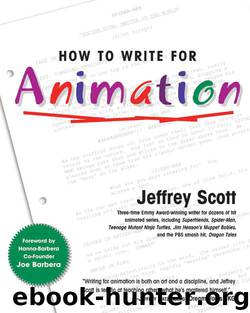How to Write for Animation by Jeffrey Scott

Author:Jeffrey Scott [SCOTT, JEFFREY]
Language: eng
Format: epub
Tags: PER000000, PER017000, REF026000, LAN005000
ISBN: 9781468304275
Publisher: The Overlook Press
Published: 2012-07-10T00:00:00+00:00
That was thirty-eight words. Now see how it reads with nineteen:
Sam leaps off the roof, drawing his Colts, dropping the bandits in rapid succession before landing on the street.
The same action was described in both. In the first example I added several “action adjectives” which one might think would give the impression of speed or excitement to the description. In fact, what gives the greatest feeling of speed to the scene is being able to read it in half the time. So try to use as few words as you can to describe what you want the reader to see. But use enough so that he or she can see it!
Another thing that can happen if you use too many words to describe your scene is that your script can actually come out short. Using too many words will make your scenes appear to be longer, while the extra words, in fact, don’t take up any more screen time. The above scene is only about 3 seconds long. The last thing you want when you turn in a script is to have the story editor tell you to go back and add more pages to bring it to length.
Cartoon pacing is generally fast. This is true for action like Batman, squash-and-stretch antics like Bugs Bunny, and even sitcoms like The Simpsons, with their rapid-fire jokes.
A simple rule to remember about pacing is to make sure that the pacing of your script is as fast as it can be without detracting from what you are trying to communicate.
Cutting is a part of pacing. A cut is the transition from one visual angle or perspective to the next. How you choose to cut from one scene to another, one angle to another, or from one character to another, affects the pacing of the script. Each slug line and shot you call out indicates a cut of some kind, regardless of whether or not you use the words CUT TO. The number of cuts (shots) you use creates a rhythm, like a drummer pounding his bass drum. This could be totally wrong for a quiet dialogue scene, while in an action sequence it might create a fast-paced, heart-pounding moment.
But description accounts for only half of your script. The other half is in the dialogue.
Download
This site does not store any files on its server. We only index and link to content provided by other sites. Please contact the content providers to delete copyright contents if any and email us, we'll remove relevant links or contents immediately.
The Kite Runner by Khaled Hosseini(5133)
Gerald's Game by Stephen King(4607)
Dialogue by Robert McKee(4353)
The Perils of Being Moderately Famous by Soha Ali Khan(4194)
The 101 Dalmatians by Dodie Smith(3482)
Story: Substance, Structure, Style and the Principles of Screenwriting by Robert McKee(3420)
The Pixar Touch by David A. Price(3389)
Confessions of a Video Vixen by Karrine Steffans(3273)
How Music Works by David Byrne(3234)
Harry Potter 4 - Harry Potter and The Goblet of Fire by J.K.Rowling(3031)
Fantastic Beasts: The Crimes of Grindelwald by J. K. Rowling(3029)
Slugfest by Reed Tucker(2972)
The Mental Game of Writing: How to Overcome Obstacles, Stay Creative and Productive, and Free Your Mind for Success by James Scott Bell(2876)
4 - Harry Potter and the Goblet of Fire by J.K. Rowling(2683)
Screenplay: The Foundations of Screenwriting by Syd Field(2602)
The Complete H. P. Lovecraft Reader by H.P. Lovecraft(2529)
Scandals of Classic Hollywood: Sex, Deviance, and Drama from the Golden Age of American Cinema by Anne Helen Petersen(2491)
Wildflower by Drew Barrymore(2466)
Robin by Dave Itzkoff(2411)
